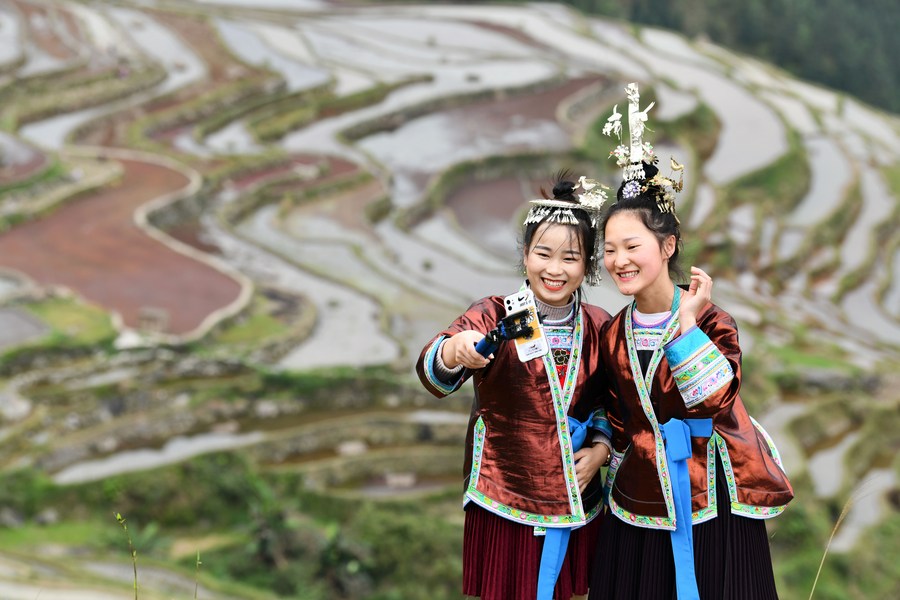


Two girls promote local tourism via live streaming at Jiache Village, Jiabang Township in Congjiang County of southwest China's Guizhou Province, April 19, 2020. (Xinhua/Yang Wenbin)
Poverty is a huge problem for countries all over the world. Poverty alleviation has long been a difficult task for the international community. Building a prosperous society has a lot of implications. Among them, the complete eradication of absolute poverty is the most fundamental condition for creating a prosperous society in general. Without moderate prosperity in rural areas, especially in poor areas, there will be no comprehensively built well-off society. At a ceremony in Beijing on February 25, 2021, China's President Xi Jinping declared “Complete Victory” in the country’s campaign to end rural poverty.
Poverty reduction is a strategic priority for China. China has slowly progressed on the path of poverty reduction over the last 70 years. Since the age of Deng Xiaoping, China's poverty alleviation efforts have gained political support from the highest levels of government. The government has carried out large-scale development-oriented poverty eradication programs across the country in a planned and organized way, and implemented a series of mid- and long-term projects which include the Seven-Year Program for Lifting 80 Million People Out of Poverty (1994-2000), the Outline for Development-Oriented Poverty Alleviation for China’s Rural Areas (2001-2010) and the Outline for Development-Oriented Poverty Alleviation for China’s Rural Areas (2011-2020).
The Communist Party of China made a solemn commitment to Chinese people to meet the needs for food and clothing, secure compulsory education, basic medical care, and housing. Farmer's income growth rate in poverty-stricken areas is higher than the national average. Basic public services are close to the national average. The goal was to eliminate absolute poverty for all rural poor, poverty-stricken counties, and to eradicate regional poverty problem.
The CPC and the Chinese government focused on the economy, formulated a basic roadmap for national development, and implemented a policy of reform and opening-up. China began reforms in the rural land system and market at the same time. Chinese leaders pledged to eliminate the “two worries” (inadequate food and inadequate clothing) and provide “three guarantees” (access to healthcare, education, and housing). China has pulled 770 million rural residents out of poverty in the four decades since reform and opening-up began in 1978.
In December 2020, President Xi said that over the past eight years of his leadership, the final 98.99 million impoverished rural residents living under the current poverty line have all been lifted out of poverty. The all 832 impoverished counties and 128,000 impoverished villages had officially bid farewell to poverty. China has blazed a new trail in poverty reduction and developed an anti-poverty theory with Chinese characteristics. With goals forming part of the UN 2030 Agenda for Sustainable Development, China has met this target 10 year ahead of schedule by contributing over 70 percent to global poverty reduction. China has made "unprecedented achievements" in rapid economic growth and poverty reduction according to a World Bank report. UN Secretary-General António Guterres stated that China has made the greatest contribution to global poverty reduction in the last 10 years.
In November 2013, President Xi paid an inspection visit to Xiangxi, Hunan Province in central China. During the inspection tour, the Chinese leader brought up the idea of "targeted poverty alleviation" for the first time. The targeted poverty alleviation strategy has been one of the most important pillars of Xi's poverty alleviation efforts. Following that, Chinese leaders began formulating specific, measurable, and time-bound goals for eradicating absolute poverty by 2020.
By the end of 2020, more than 3 million officials were sent to the countryside, where they worked for one to three years to improve conditions in impoverished areas. China spent around 600 billion yuan on resettlement housing during the 13th Five-Year Plan (2016-2020) period. During an inspection tour in northwest China's Ankang, Shaanxi province in April 2020, Xi said, "I am confident of achieving the target of poverty eradication this year."
Targeted poverty alleviation is achieved with a five-pronged policy, focusing on industrial development, relocation, eco-compensation, education, social security, and established seven institutional systems (registration, policy, investment, assistance, social mobilization, multi-channel, all-around supervision, and assessment system).
Those living in poverty-stricken areas are mainly rural people and were the first to feel the impact of economic reforms. Taking this into account, the authorities have attempted to encourage farmers to expand agricultural output and sales, hence raising farmer’s real income. The Chinese government helps underprivileged areas improve their infrastructure by utilizing local resources. The Chinese saying "Build roads first to get rich" has become a key approach in China's poverty-reduction efforts. The government has also made significant investments in infrastructure as part of its anti-poverty efforts. The improvement of transportation has given residents the opportunity to enter the cash crops market and obtain medical care and education.
In the poverty reduction campaigns in China, tourism has become a highly profitable industry, and it has tremendously aided the development of rural areas. Tourism has created a large number of jobs, particularly in locations where other economic activities are difficult to promote. China has been fostering the growth of environmentally friendly tourism by bolstering policy assistance. Forest tourism has aided many individuals in China's remote locations in escaping poverty. In 2018, China's 1.475 million registered poor people realized income increase through forest tourism, with an average annual household income increase of 5,500 yuan.
China is like a train running on a solid track, moving fast in a clear direction at an amazing speed. China uses technology to get rid of poverty, such as the use of drones for spraying pesticides, providing farmers with sales channels through e-commerce platforms. China addresses poverty through live broadcasting, claiming that the changes in consumption habits caused by the development of the internet have brought huge opportunities for the development of rural areas in China.
The Coronavirus epidemic is currently having a significant impact on the global economy. The pandemic has basically been contained in China, and the economy has stabilized and recovered. Having achieved such remarkable poverty reduction achievements in such a short period of time, it should be said that China has made historic achievements in eradicating absolute poverty. For some Western critics, eradicating poverty in a country of 1.4 billion people may seem too ambitious or unrealistic.
However, it is a mission that must be accomplished for China because the purpose of socialism is to achieve common prosperity. CPC members and government officials at all levels have made concerted efforts to combat poverty, guided by the ideology of putting people first. If world leaders are serious about ending the tragedy of extreme poverty that continues to affect millions of people, they will draw on China's experience and newfound willingness to share their model by deploying new innovation.
Contributed by Mohammad Saiyedul Islam, Senior Research Fellow at Daffodil International University Belt and Road Research Centre

点击右上角![]() 微信好友
微信好友
 朋友圈
朋友圈

请使用浏览器分享功能进行分享
